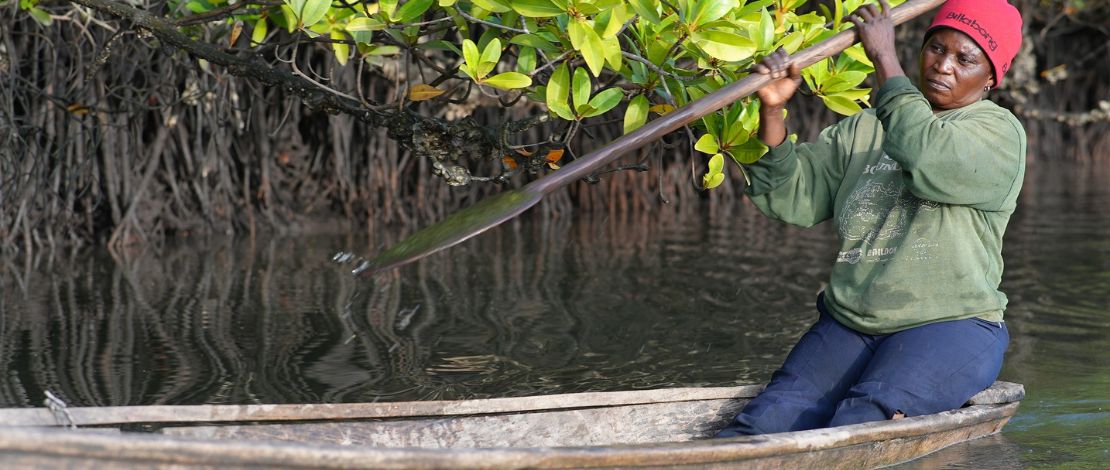Restoring mangroves for climate-resilient fisheries in the Gambia

Women oyster farmers collect oysters in the mangroves
©FAO/Sylvain Cherkaoui
The Gambia contributes just 0.01 percent to global greenhouse gas emissions, but climate change threatens the future supply of people’s main source of protein: fish. In this low-lying coastal nation, rich in biodiversity with over 600 fish species, poor fisherfolk depend on marine, coastal and riverine fisheries for their food security and livelihoods.
Every year, Gambians consume about 32 000 tonnes of fish, which is sourced from the artisanal fisheries sector. Each day, fisherfolk go out in their small boats on short fishing trips, bringing back their catch to be consumed by the local population.
But the impacts of climate change – such as increases in water temperature, salinity and acidity – threaten to deplete fish stocks. Similarly, extreme winds, high waves and sea level rise are expected to cause damage to fisheries infrastructure, leading to higher food waste and loss in the fish value chain.
How can the Gambia – a Least Developed Country with limited resources – take action to help poor fisherfolk and vulnerable communities become more resilient to climate change? Nature is the solution, and restoring critical mangrove ecosystems is the key.
The Food and Agriculture Organization of the United Nations (FAO) is working with the Government of the Gambia on the implementation of a Green Climate Fund (GCF) project – with USD 25 million in investments – focused on climate-proofing fisheries infrastructure, and restoring over two thousand hectares of degraded mangrove areas, which are critical fisheries hotspots.
-(3).png?sfvrsn=c0886d76_5) Mangrove aerial view. Photo credit: Dan Roizer
Mangrove aerial view. Photo credit: Dan Roizer
Restoring mangroves for a better environment and better life
The River Gambia sustains livelihoods and nature; it flows across the country towards the Atlantic Ocean, meandering through mangrove forests in a massive estuary brimming with life above and below water.
These dense mangrove ecosystems are vital breeding grounds and nurseries for major shellfish and fish species, such as shrimp and barracuda. They also protect coastlines and riverbanks from erosion by capturing and trapping sediment. Yet over the last 15 years, the Gambia’s mangrove cover has shrunk at an average rate of 1.5 percent per year because of climate and human induced degradation, such as the unsustainable harvesting of wood for poles and wood fuel.
Protecting and restoring these life-sustaining mangrove ecosystems is essential for the conservation of biodiversity, the preservation of livelihoods, and the long-term sustainability of the country’s fisheries sector.
 Oyster harvester Cecilia Sambia is paddling her canoe to the creek. Photo credit: © FAO/ Njapu Njie
Oyster harvester Cecilia Sambia is paddling her canoe to the creek. Photo credit: © FAO/ Njapu Njie
As part of the FAO-led PROREFISH Gambia project, efforts to restore degraded mangroves will focus on assisted natural regeneration using a mix of species that are particularly salt tolerant.
Restoring mangrove ecosystems is expected to increase overall fish availability by as much as 20 percent, which will in turn raise poor fisherfolk’s incomes and maintain per capita fish availability.
Communities as mangrove custodians
Local communities have a critical role to play as guardians of mangrove ecosystems. With support from the Departments of Forestry and of Parks and Wildlife, women and female youth will be trained in mangrove monitoring, conservation and sustainable resource use, and communities will assume tenure over the plots they have helped to restore.
“Women will be active participants and equal beneficiaries in project activities aimed at restoring degraded mangrove areas in key fisheries hotspots,” says Moshibudi Rampedi, FAO Representative in the Gambia.
-(2).png?sfvrsn=e5de8f2f_3) Woman harvesting oysters. Photo credit: FAO Njapu Njie
Woman harvesting oysters. Photo credit: FAO Njapu Njie
Investments in aquaculture provide a complementary solution to the threats facing the Gambia’s fisheries sector. Communities will receive hatchery and feed plants to produce juvenile fish – known as fingerling because they are 10 to 15 centimetres long, or about the size of a finger. Beneficiaries will also receive support to integrate fish production in rice fields, climate-proof existing fishponds, and increase oyster culture in mangrove forests and on tidal flats.
To reduce loss and waste during landing, handling and processing activities, fisheries infrastructure, such as landing sites, will be upgraded with more durable materials and equipment to become more climate resilient.
Pioneering initiative for sustainable agrifood systems
The PROREFISH project is the first GCF project to focus primarily on the fisheries sector. Approved by GCF in July 2022, the project recently moved into the implementation phase following the inception workshop held in Banjul on 12 April 2023. Over 11 000 Gambian households will benefit directly from the six-year initiative, and more than 46 000 households will benefit indirectly, which amounts to nearly one-sixth of the population.
Speaking at the inception workshop, FAO’s Rosalie Lehel said, “We are particularly proud of PROREFISH as, being the first GCF-funded project with a major focus on fisheries, it can be a catalyst for a paradigm shift by offering best practices that can be replicated and scaled up in other countries dependent on fisheries for food security.”
A more sustainable fisheries sector will not only protect the rich, biodiversity housed in mangrove ecosystems, but will also lead to more efficient, inclusive, resilient and sustainable agrifood systems for better production, better nutrition, a better environment, and a better life, leaving no one behind.
For more information on this topic, see the FAO-GCF Partnership website and the Green Climate Fund.


